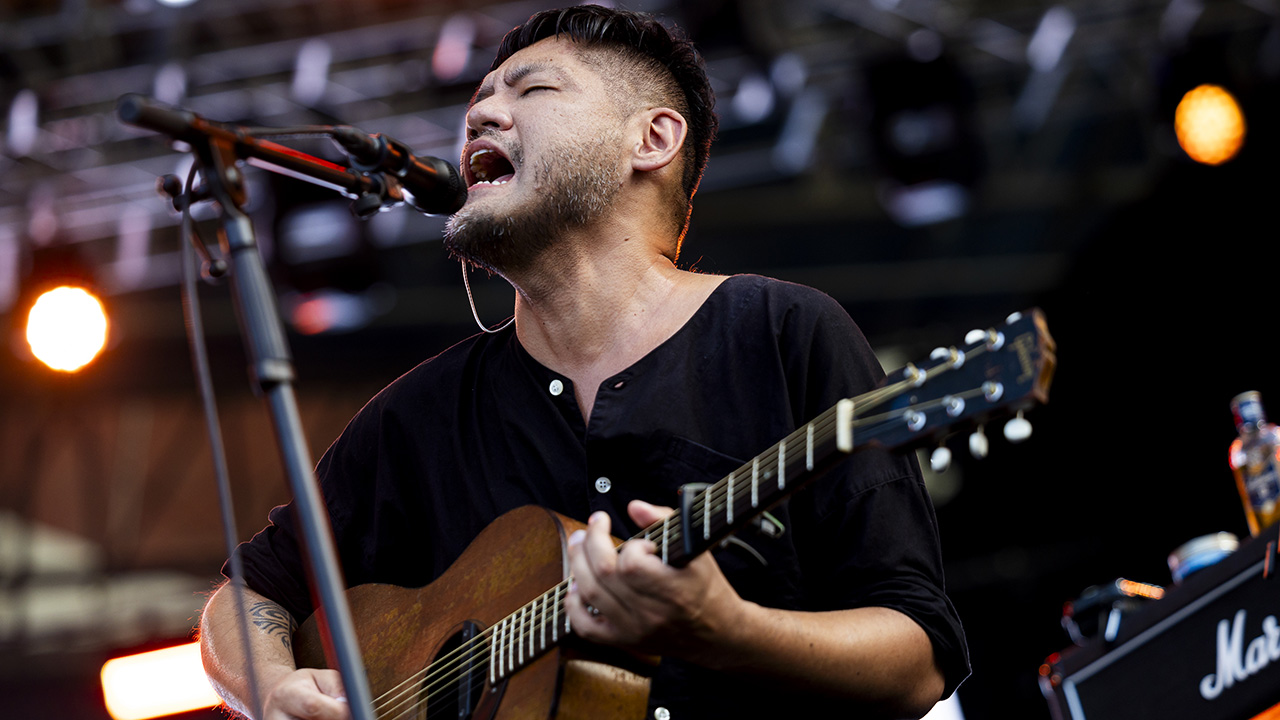Best Ibanez guitars 2025: 13 standard and signature Ibanez models for every budget
Our pick of the best Ibanez guitars for beginner to pro players, along with useful buying advice
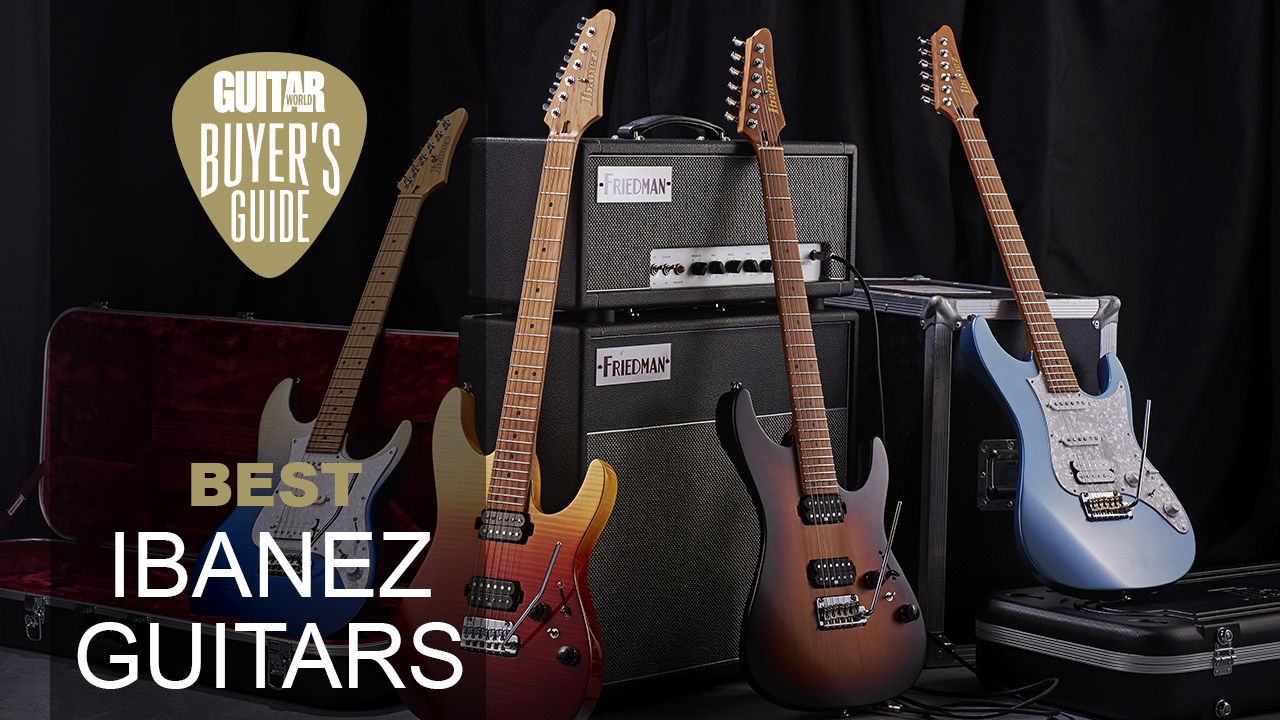
The best Ibanez guitars come in all shapes, sizes, finishes and price points – so whether you’re after a budget-friendly shred machine, a well-priced hollowbody, or a high-end Superstrat, there’s something for you in Ibanez’s vast product catalog.
While Ibanez is possibly best-known for the signature guitars of the virtuosic Steve Vai and Joe Satriani, your options are much more than a deluge of gain and divebombs. Modern blues icon Josh Smith has his FLATV signature – an out and out blues machine – and Yvette Young’s YY10 and YY20 signature models offer some of the sweetest clean tones around.
Whatever style or tone you’re looking for, it can be achieved with an Ibanez - and here’s where this guide comes in. We’ve arranged 13 of what we think are the best Ibanez guitars in price order, lowest to highest, to make things a bit easier. At the end of this guide is some expert buying advice, so if you’d like to read more about the best Ibanez guitars, and what to know about when buying one, head to the bottom of the page now. If you’d rather just get to the products, keep on scrolling.
Best Ibanez guitars: Our top picks
If you’re just starting out and looking for a great beginner electric guitar, or just looking for a killer budget electric guitar, we’d recommend the Ibanez AZES31. Everyone wants to play a guitar that looks like something their guitar heroes would pick up, and this budget-friendly AZ model offers that exact experience. Available in some stunning colors, and with options for either SSS or HSS pickup configurations, this guitar is well worth a look.
For the intermediate guitarist, you’ll be looking at spending up to about $1,200 on a new Ibanez. If this is you, then we’d suggest you look no further than the Ibanez YY10. Not only is Slime Green Sparkle one of the coolest finishes we’ve seen in forever, but the Strat-style pickup configuration coupled with the 12” fingerboard radius is our idea of the perfect vintage/modern blend.
For the professional players among us, we’d recommend the AZ2204 Prestige. Granted, Ibanez does have some fancier models in the form of the Jem and PIA, but for straight up playability, versatility and reliability, the AZ2204 is the one for us. Equipped with heavy duty Gotoh hardware and Seymour Duncan pickups as stock, your only real limitation is your creativity when it comes to the AZ2204 – or any of the AZ Prestige models, for that matter.
Best Ibanez guitars: Product guide
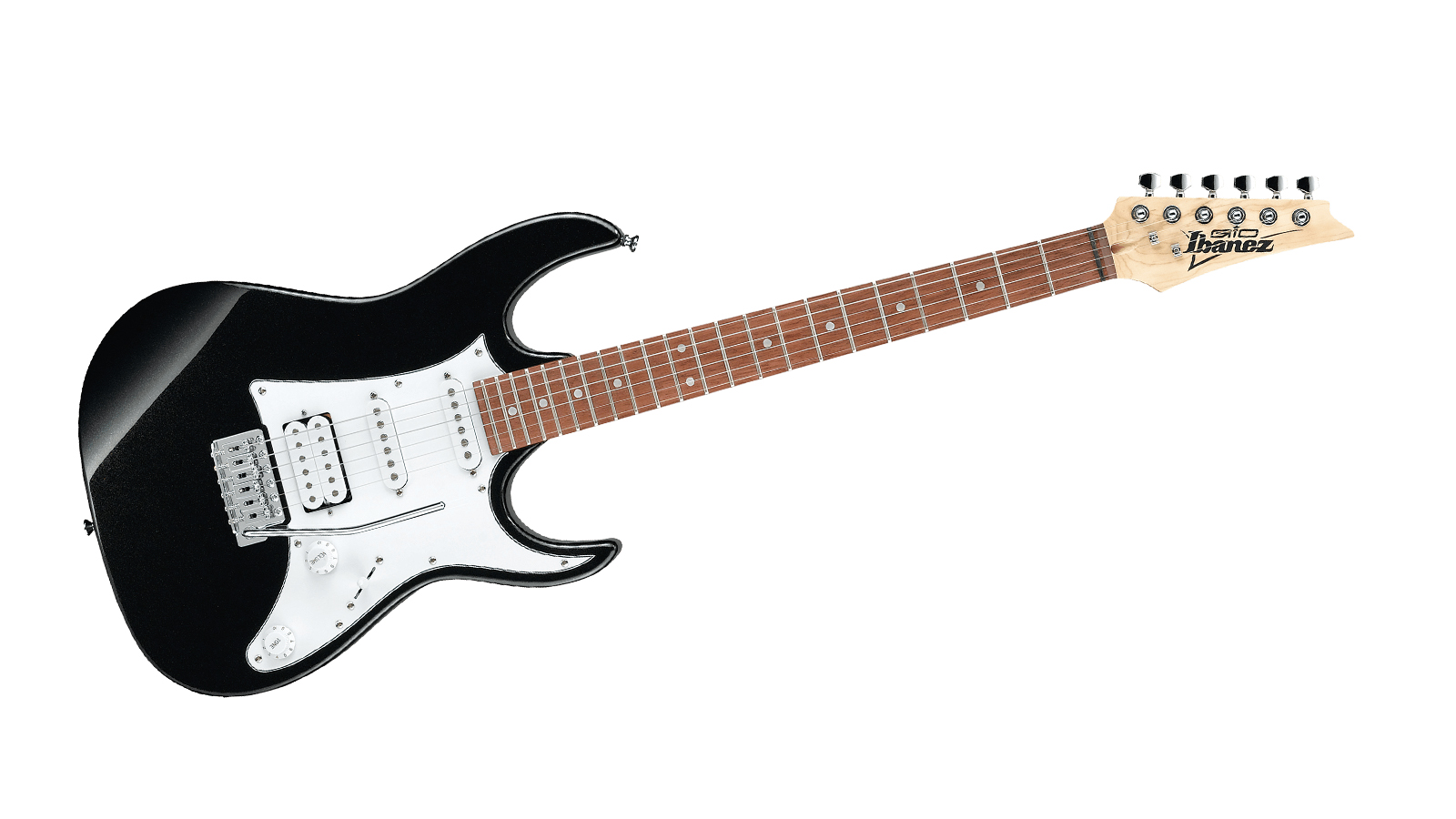
1. Ibanez GRX40 GIO
Our expert review:
Specifications
Reasons to buy
Reasons to avoid
There aren’t many brands that do budget electric guitars quite like Ibanez. Their GIO range offers impressive quality and playability, and this GRX40 is no exception to that rule.
A combination of a Poplar body, Jatoba fingerboard and a GRX Maple neck offers any player a heap of punchy brightness, perfect for carving a hole through any mix. The HSS pickup configuration brings a balanced and versatile tonal palette thanks to three ceramic Infinity pickups.
The GRX40 GIO is a perfect beginner electric guitar for those on the smallest of budgets, with hardware and build quality beyond its price point, and added touches like the ‘mono-unit’ output jack – a one-piece output jack construction – makes this guitar even easier to just get on and play.
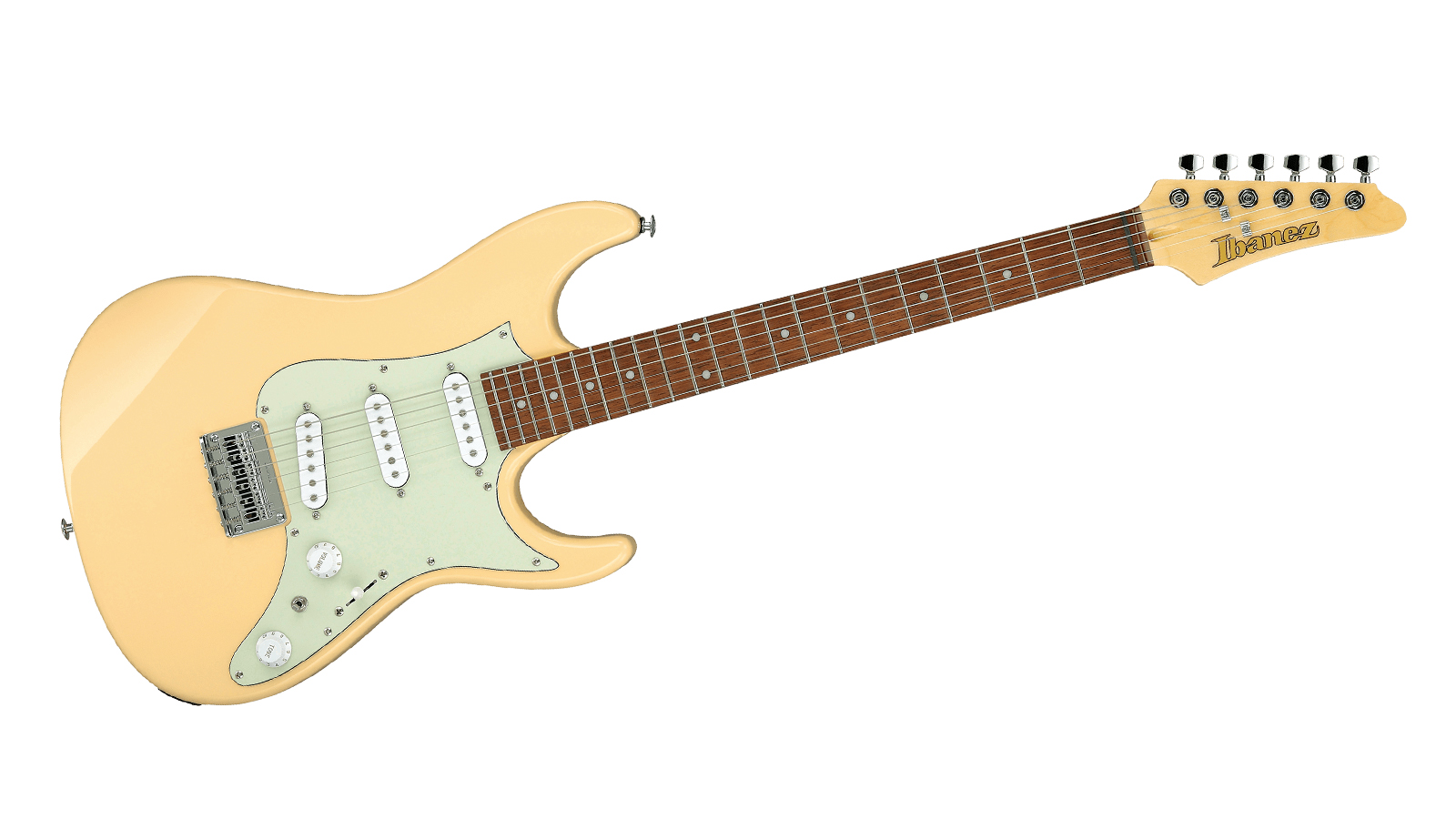
2. Ibanez AZES31
Our expert review:
Specifications
Reasons to buy
Reasons to avoid
The Ibanez AZES31 is, in our opinion, the very best budget Ibanez electric guitar you can buy right now. Similar to the GIO mentioned above, this AZ Essentials model also consists of a Poplar body, Maple neck and Jatoba fingerboard, offering up that bright, snappy tonality that so many players adore.
This model is available with three ‘Essentials’ single-coil pickups, which deliver traditional tones with a bit of an edge when required, making this model perfect for near enough any style of playing.
The scale length on this guitar is a little bit shorter than the rest, coming in at 25” – a sweet middle-ground zone for many players. This is a little shorter than a standard Fender-style scale length, so string bending is easier and overall string tension is a little lower – making playability easier. The fingerboard radius – 250mm or 9.8” – is a middle-ground spec choice also, making this instrument super versatile and suitable for anything.
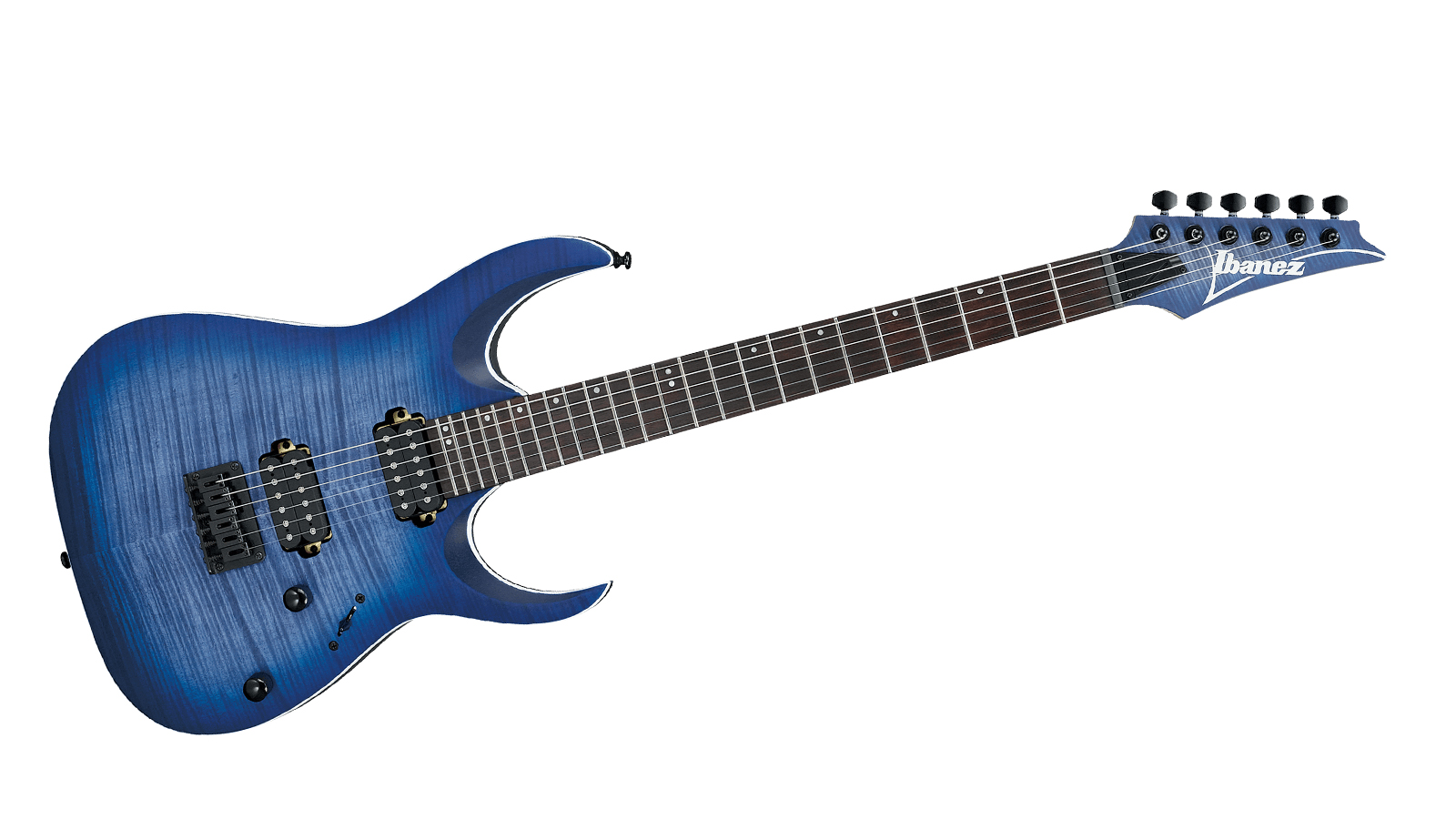
3. Ibanez RGA42FM
Our expert review:
Specifications
Reasons to buy
Reasons to avoid
The RGA42FM doesn’t have the catchiest product name, but what it lacks in name, it entirely makes up for in its performance. The seemingly ‘standard’ combination of a Maple neck and Jatoba fingerboard grace this RGA model, but the body is made from Meranti as opposed to Poplar. A flamed Maple top is the icing on this RGA’s aesthetic cake, and in any of the available finishes, this guitar looks epic.
With Meranti being a darker wood, closer to Mahogany in tone and color, the RGA42FM delivers impressive sustain. The much lighter top and neck woods help to brighten up the tone of the instrument rather well, drawing the best from that pair of Quantum humbuckers. A 5-way selector switch offers an impressive amount of tonal capabilities, but we wish that the bridge pickup could be used in parallel.
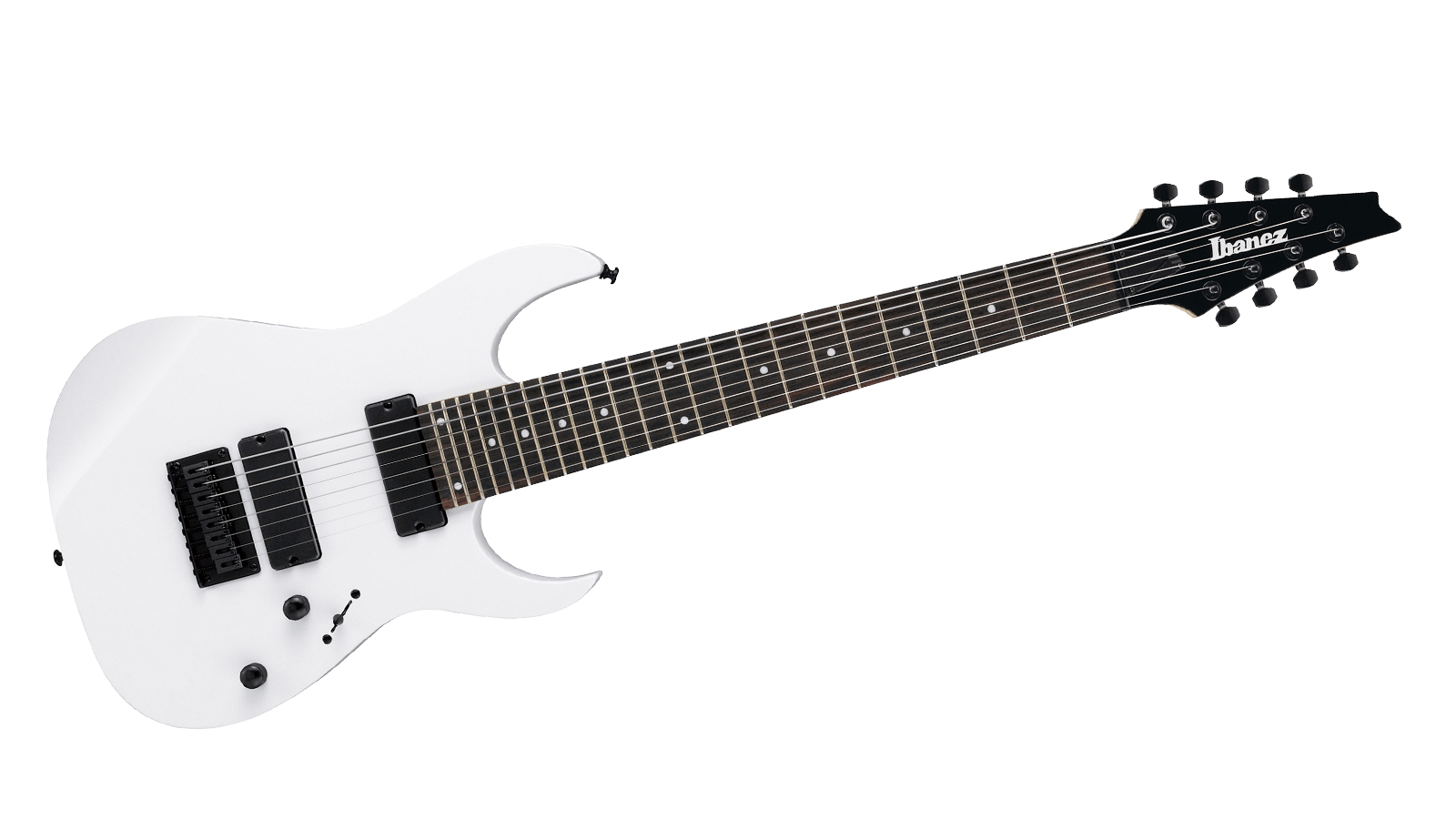
4. Ibanez RG8
Our expert review:
Specifications
Reasons to buy
Reasons to avoid
The Ibanez RG8 is one of Ibanez’s most well-known and easily recognizable guitars. With Ibanez responsible for the first mass-produced seven- and eight-string guitars, it seems only fair that the RG8 gets a shout out in this guide.
This guitar has a five-piece Maple/Walnut neck, Meranti body and Jatoba fingerboard – and it’s this combination of warmth from the body, top end brightness from the neck and a snappy response from the fingerboard material which makes the RG8 such a balanced instrument. It’s difficult to get the best out of an 8-string guitar at the best of times, so this material combination, along with the pair of Ceramic IBZ-8 humbuckers brings players loads of tonal opportunity, as well as lots of clarity in the lower registers where things can start to sound a bit muddy.
A temptation with 8-strings is to tune them even lower than usual – and Ibanez knows this – so much so that they’ve routed out a ferrule on the back of the guitar for a bass string. This is all well and good – and so much fun – but we’d advise getting your guitar professionally set up every time you go wild with string gauges. Your intonation will thank us later!
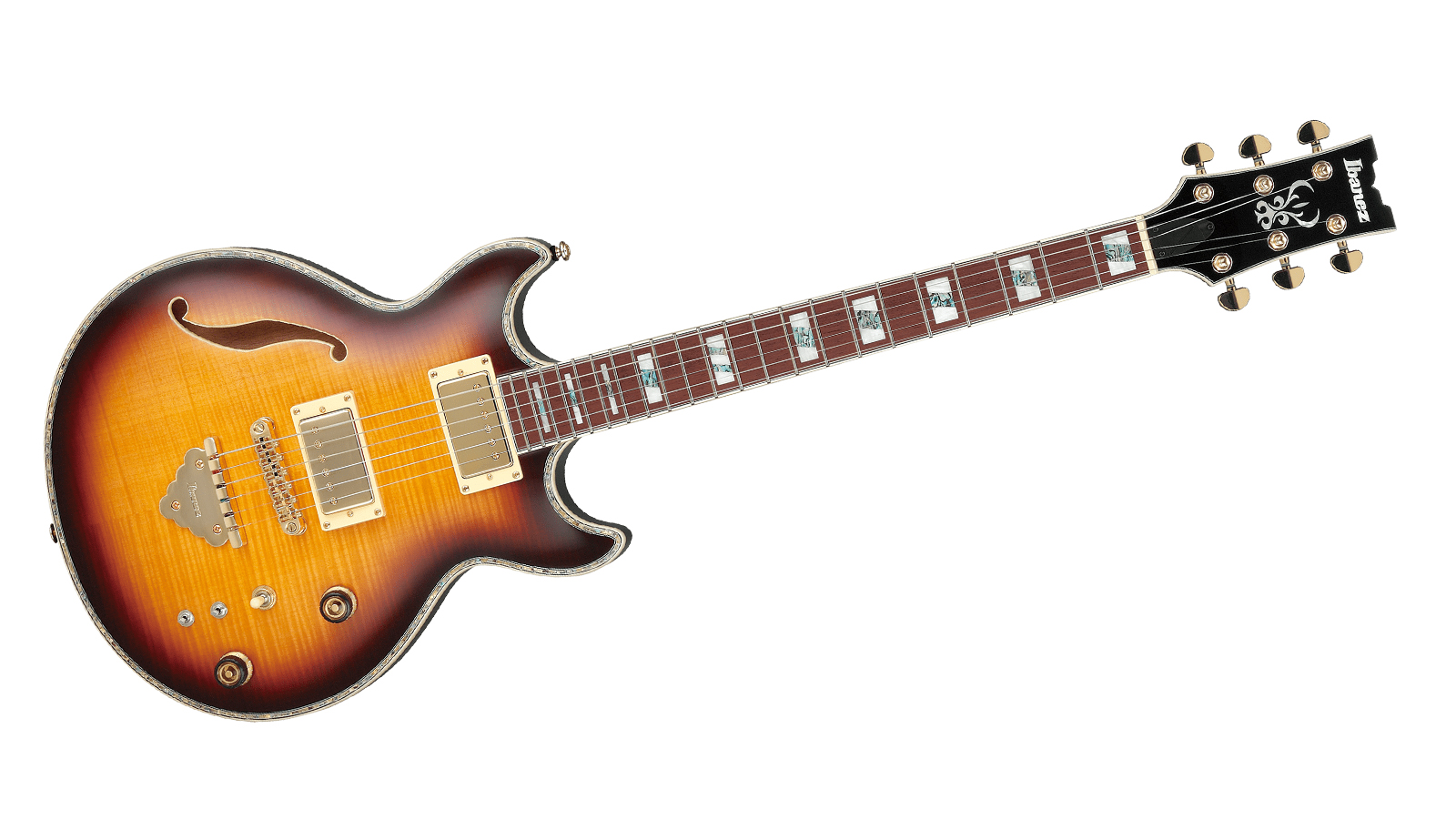
5. Ibanez AR520HFM
Our expert review:
Specifications
Reasons to buy
Reasons to avoid
Ibanez, whilst being mostly well known for their shred-friendly Superstrats, produce some gorgeous semi and fully hollow bodied guitars. This AR520HFM is no exception.
Crafted from a combination of a Maple top and sides and an Okoume back, the body of this guitar produces warm, sweet resonance you just can’t get from a solidbody. The neck is a 3pc Maple set neck which adds to the impressive sustain this guitar creates, and like all Ibanez guitars, its slim, comfortable profile sets this guitar apart from other semi-hollow options at this price point.
The Gibraltar Performer bridge and Quik Change classic tailpiece are both super solid pieces of hardware which instill confidence while we’re playing this guitar, and a pair of Super 58 pickups – with accompanying Tri sound switching systems – deliver 12 possible tonal options on this AR520HFM. Although it can take a long time to recall a specific tone, once we’ve found what works, this extended tonal palette can only be a good thing.
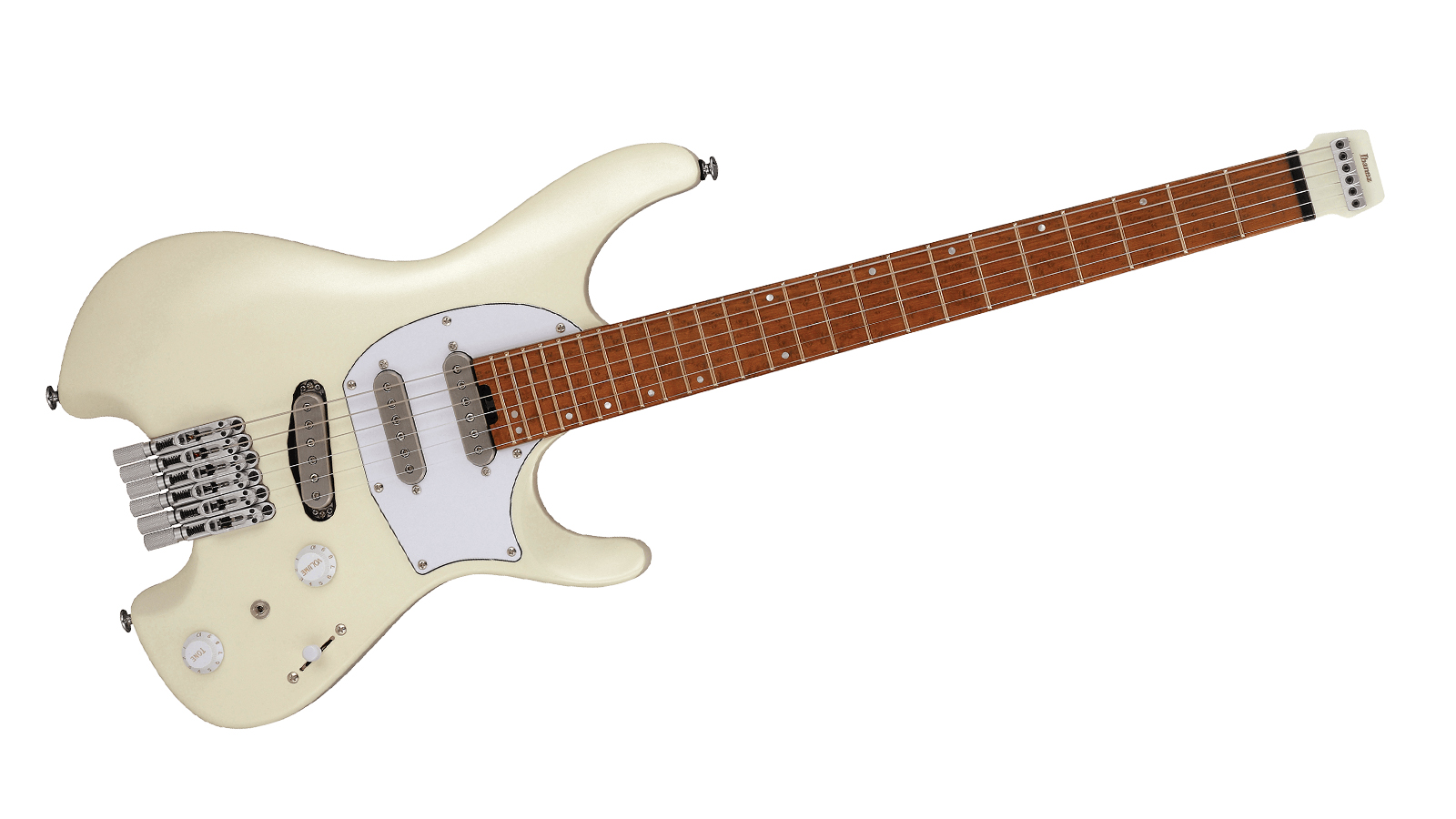
6. Ibanez ICHI10
Our expert review:
Specifications
Reasons to buy
Reasons to avoid
Welcome to our first signature model of the evening, everyone. Ibanez’s artist roster features some of the guitar world’s most intriguing and exciting new talent, and Ichika Nito seems to be the most intriguing and exciting of them all. His signature guitar model, based on the Ibanez Quest series of electric guitars, is an ultra-modern headless offering.
The ICHI10 consists of a Nyatoh body, which is tonally similar to Mahogany, and a neck made from roasted Maple and Bubinga. The blend of these woods gives the ICHI10 a balanced tone, and there’s plenty of scope for a punchy top end when you lay into it thanks to the bolt-on neck. The roasted birdseye Maple fingerboard – first of all – looks amazing, but also adds to the tone in the form of a musical brightness which really makes the guitar sing.
Three R1 ceramic single coil pickups and an onboard ‘alter’ switch offer a player 10 different tonal options, making this guitar one versatile beast.
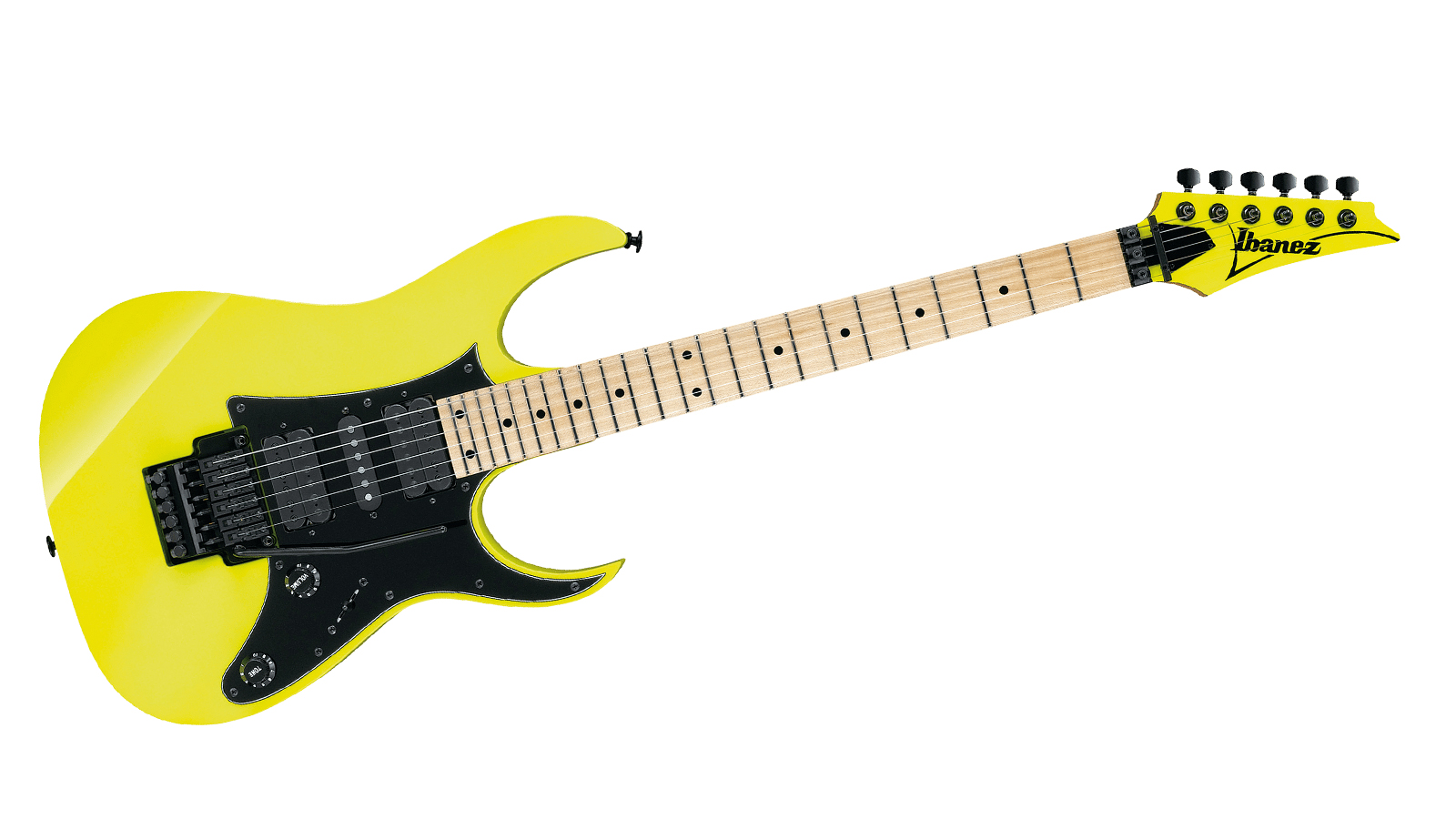
7. Ibanez RG550 Genesis
Our expert review:
Specifications
Reasons to buy
Reasons to avoid
Since its introduction in the late ‘80s, the RG550 has become a cult classic in the world of Ibanez, and rightfully so. This guitar and its crazy finish options took the late ‘80s by storm, and it continues to do so in this new and updated version.
Available in Desert Sun Yellow, Road Flare Red and Purple Neon, there are few guitars that stand out the way this one does. This Ibanez – thanks to the V7 and V8 humbuckers and S1 single coil pickup onboard – stands out for its tone too. The HSH configuration offers some fairly impressive levels of tonal versatility, and with a mostly Maple neck and Basswood body supplying the bright sounding, punchy tone that’ll catapult you through any mix, the RG550 Genesis could just be exactly what you need in your life.
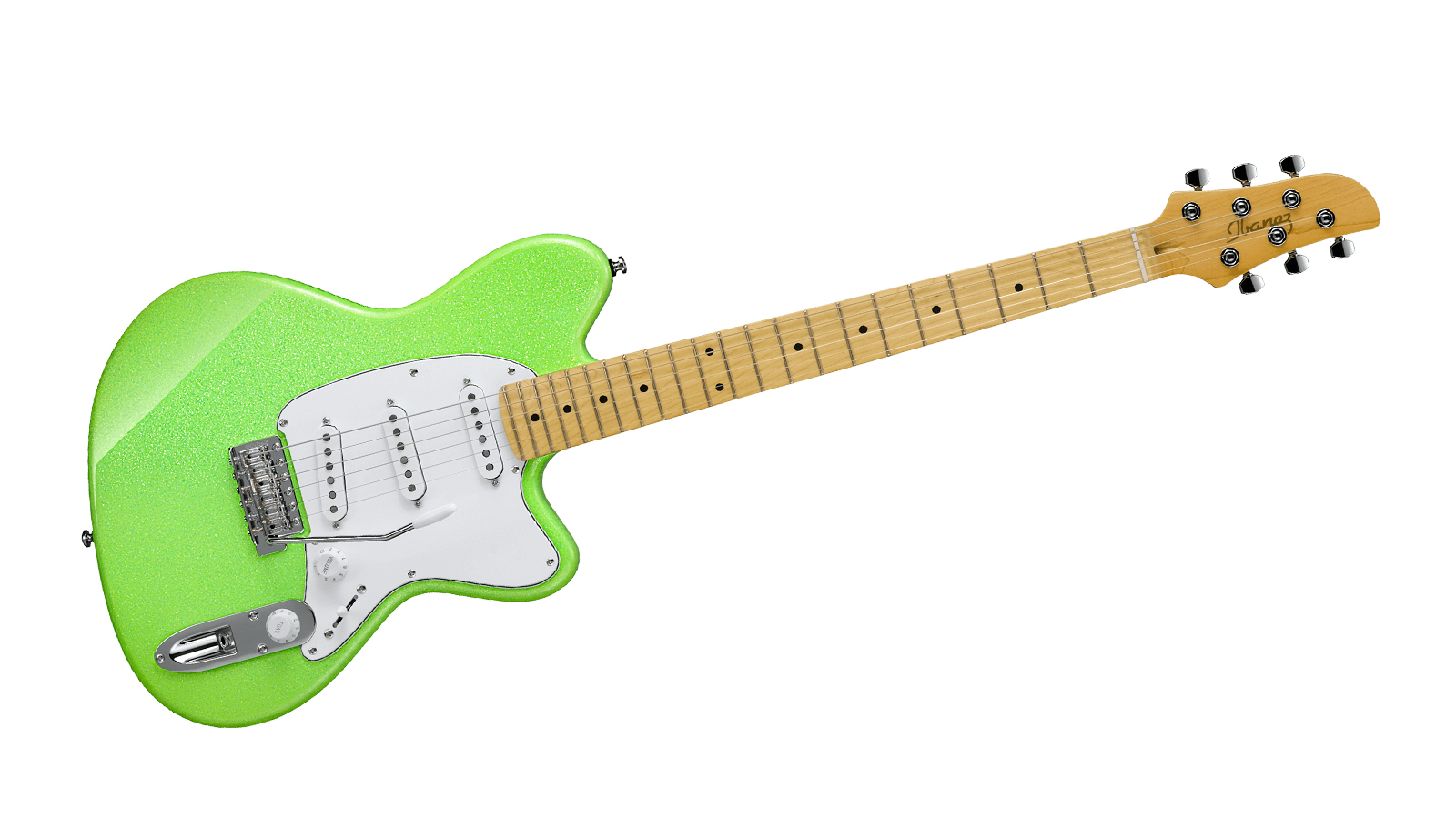
8. Ibanez YY10 Yvette Young
Our expert review:
Specifications
Reasons to buy
Reasons to avoid
If you’ve been keeping up to date with modern guitar playing, you’ll know all about Yvette Young and her unique playing style. For those who are unaware, Yvette Young plays guitar in instrumental math rock band Covet, and her next-level playing ability and eight-finger tapping has helped cement their place as one of the best in the genre. Ibanez obviously thought so too, announcing her signature model, the YY10, in early 2020.
The YY10 is essentially a Strat-style Ibanez Talman – with the traditional SSS pickup configuration and Strat-style trem displaying why sometimes, there’s no need to divert from the classics. The pickups – Seymour Duncan’s Five-Two single coils – deliver stunning, precise cleans. That tonal ‘edge’ translates well through a dirty guitar amp too.
The combination of an Alder body and a bolt on Maple neck brings the Strat-esque snappiness we know and love, but to get that tone from a super-playable offset with a 12” fingerboard radius? Yes please – we’ll have five.
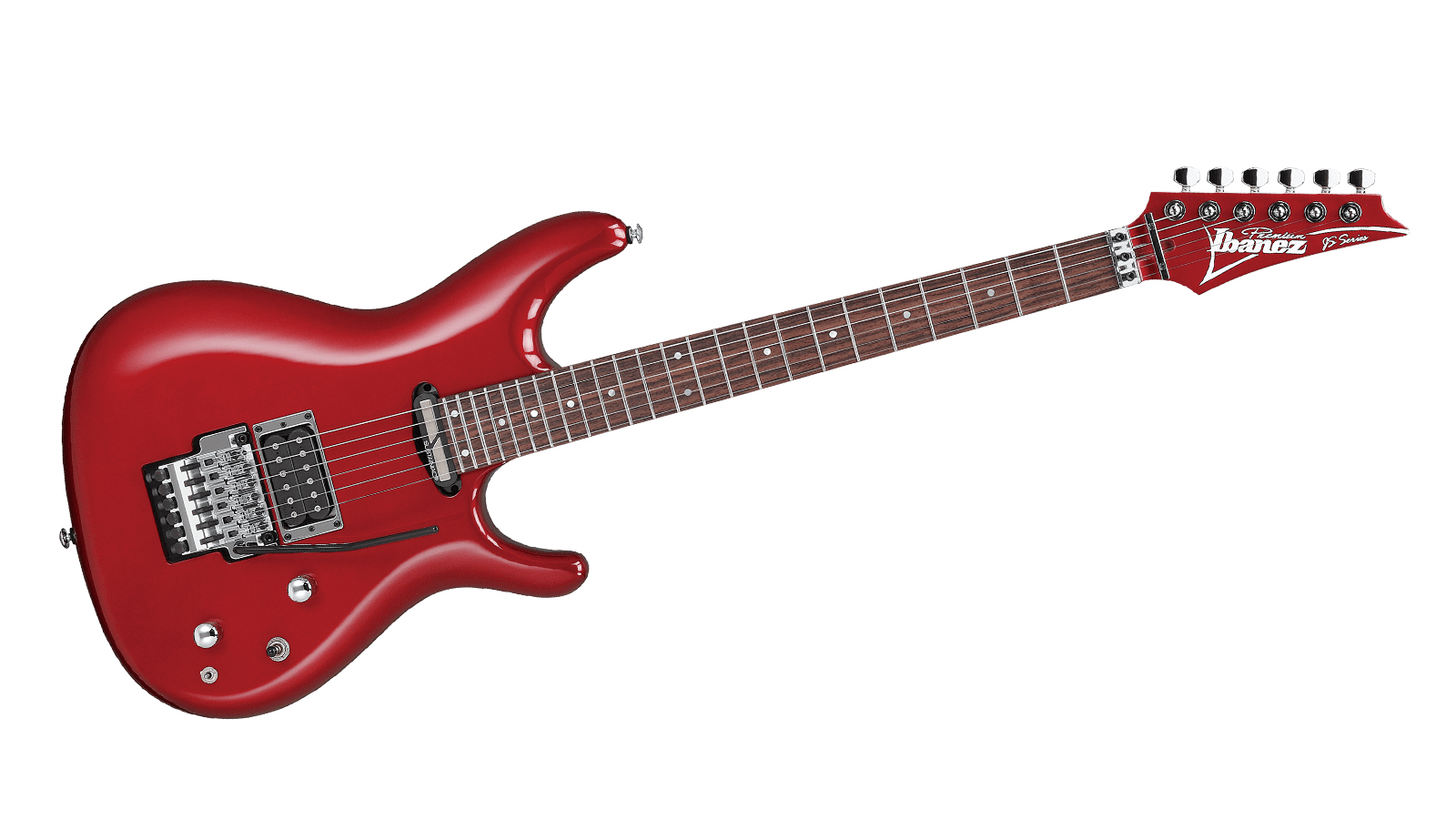
9. Ibanez JS240PS
Our expert review:
Specifications
Reasons to buy
Reasons to avoid
Well, if you know about Ibanez guitars, you probably know about Joe Satriani. One of the guitar greats of the late-’80s, ‘90s and beyond, Satch has influenced scores of guitarists with his impressive legato playing, vocal-esque melodies and blazing solos.
The JS240PS comes from a very long line of Satriani signature models, and although it’s not quite at the level of some of the really high-end options, it’s an affordable shredder’s dream. The neck is specifically designed for Satch and his JS models, and being a titanium reinforced Maple/Bubinga 3-piece construction, you’ve no reason to worry about anything other than your playing.
The Sustainiac in the neck position brings with it a raft of cool effects and tones. Switch between mix, harmonic and normal modes via the small toggle switch, and blend with the DiMarzio ‘The Satchur8’ humbucker for a real signature Satriani vibe. All of the switching can get a bit confusing at times, but the tones are happily worth the effort.
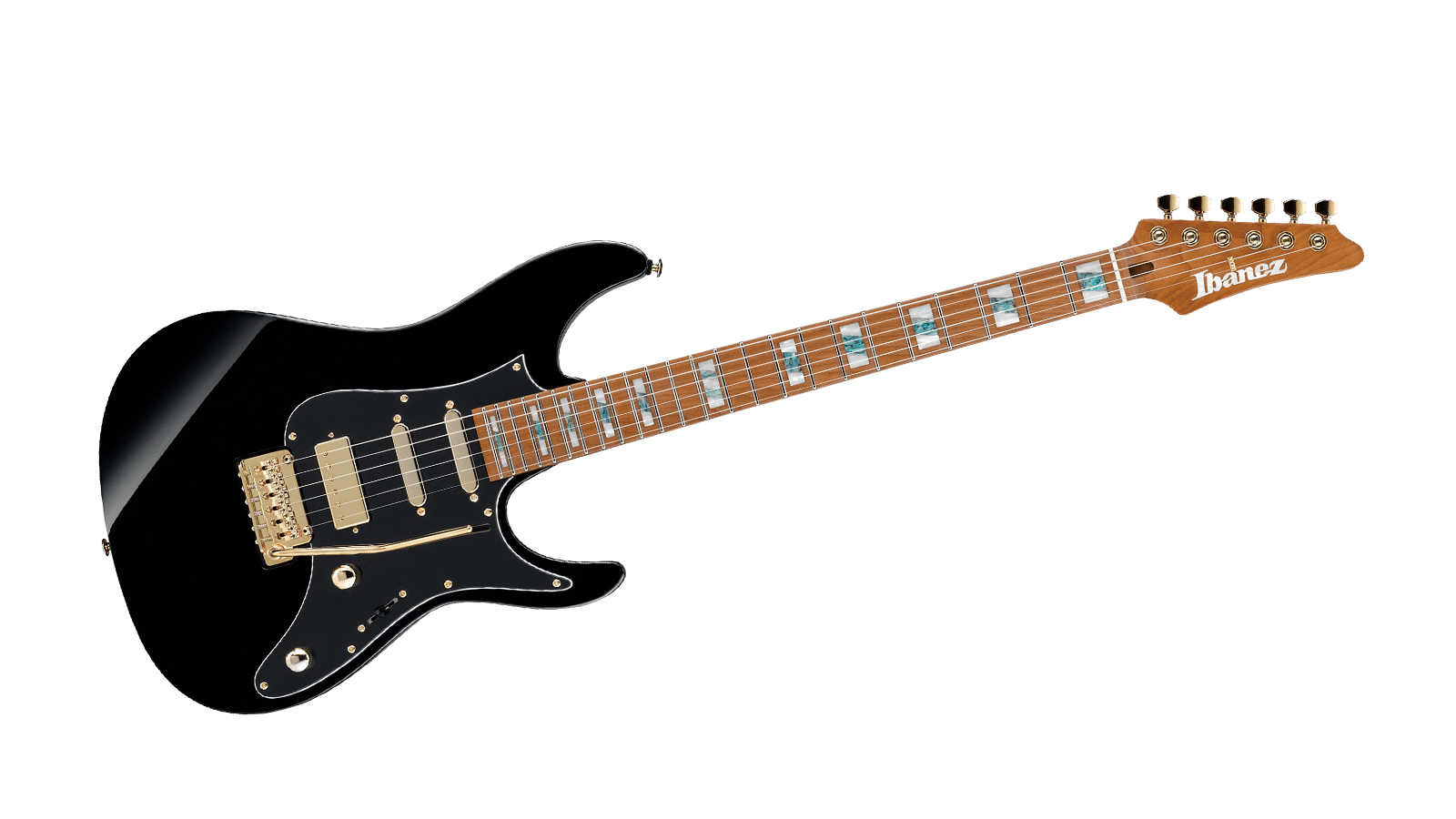
10. Ibanez THBB10 Tim Henson
Our expert review:
Specifications
Reasons to buy
Reasons to avoid
Ibanez prides itself on having one of the coolest and most diverse artist rosters around, and Tim Henson has to be one of the most interesting of the bunch.
One quarter of the band Polyphia, Henson’s signature THBB10 is a blend of traditional and modern styles. The black finish, gold hardware and big block inlays are reminiscent of the ‘Black Beauty’ Les Paul Custom, and while the looks are traditional, the guitar itself is the modern guitarist's dream.
A Basswood body and roasted Maple neck and fingerboard provide crisp and precise tonal clarity. This construction enables Henson’s own DiMarzio ‘Notorious’ signature pickup set to flourish – delivering wide-open sounding clean tones or gurn-inducing dirt when needed. Gotoh’s T1502 tremolo and MG-T locking tuners round off this stylish signature axe, making it one of the most versatile on the market at this price point.
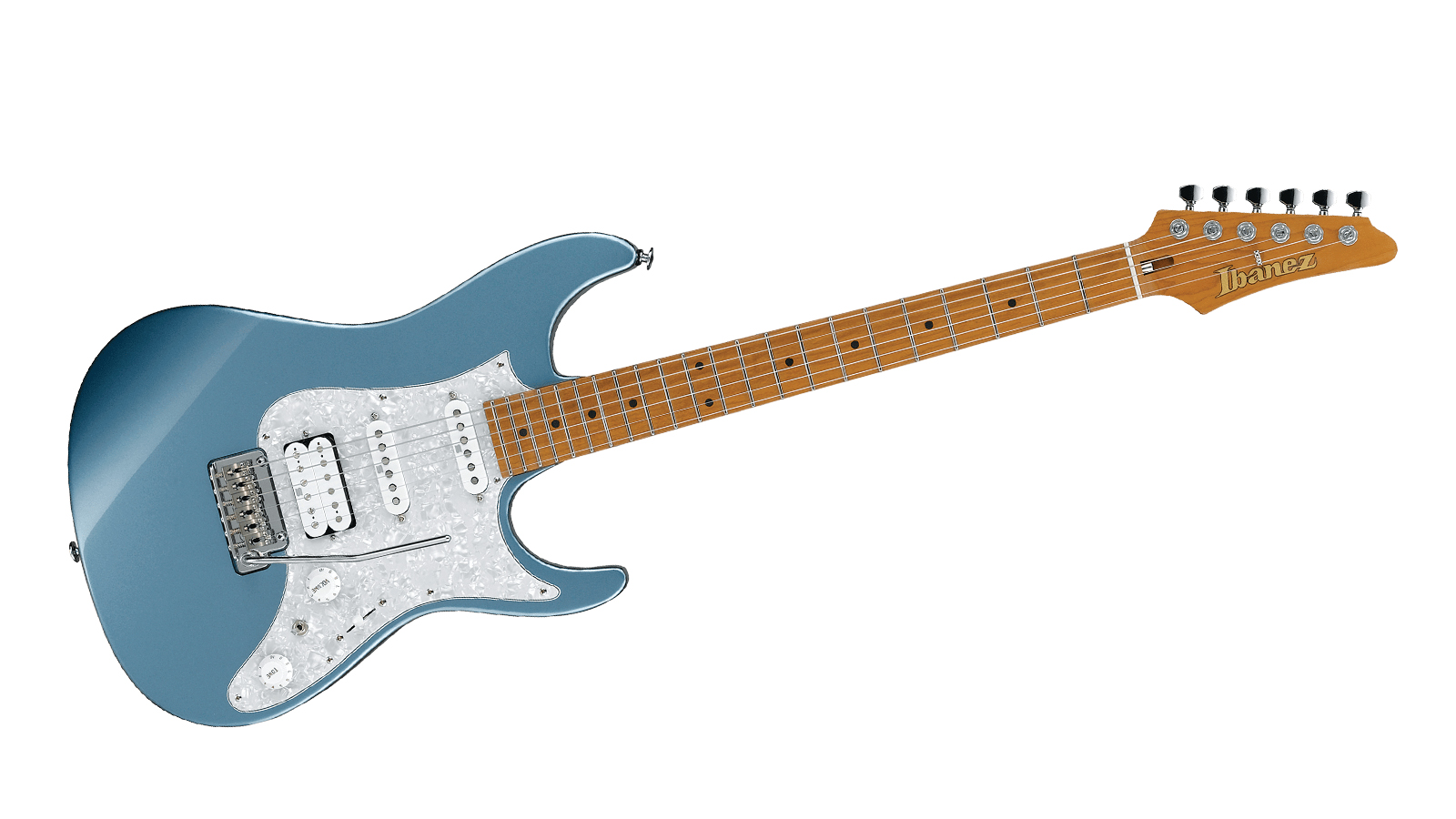
11. Ibanez AZ2204 Prestige
Our expert review:
Specifications
Reasons to buy
Reasons to avoid
Ibanez's Prestige level of craftsmanship is impressive at the best of times, but these AZ models – especially the AZ2204 – are taking the Prestige nametag to a whole new level of quality.
An Alder body and roasted maple neck, much like the majority of Strat-style guitars, deliver that 'Stratty' snap that makes these types of guitars sit so will in any style of music or mix – while the HSS-configured set of Seymour Duncan Hyperion pickups take care of the heavy lifting. Their Alnico 5 magnets deal a balanced and versatile hand – making the AZ2204 truly sing.
With jumbo stainless steel frets and Prestige fret-edge treatment, a bone nut and Gotoh hardware, this AZ2204 Prestige, like many other Ibanez guitars, is designed to be all about playing. Remove the variables of dodgy fretwork or sub-par hardware, and you've got yourself a guitar that will keep on giving back for years to come.
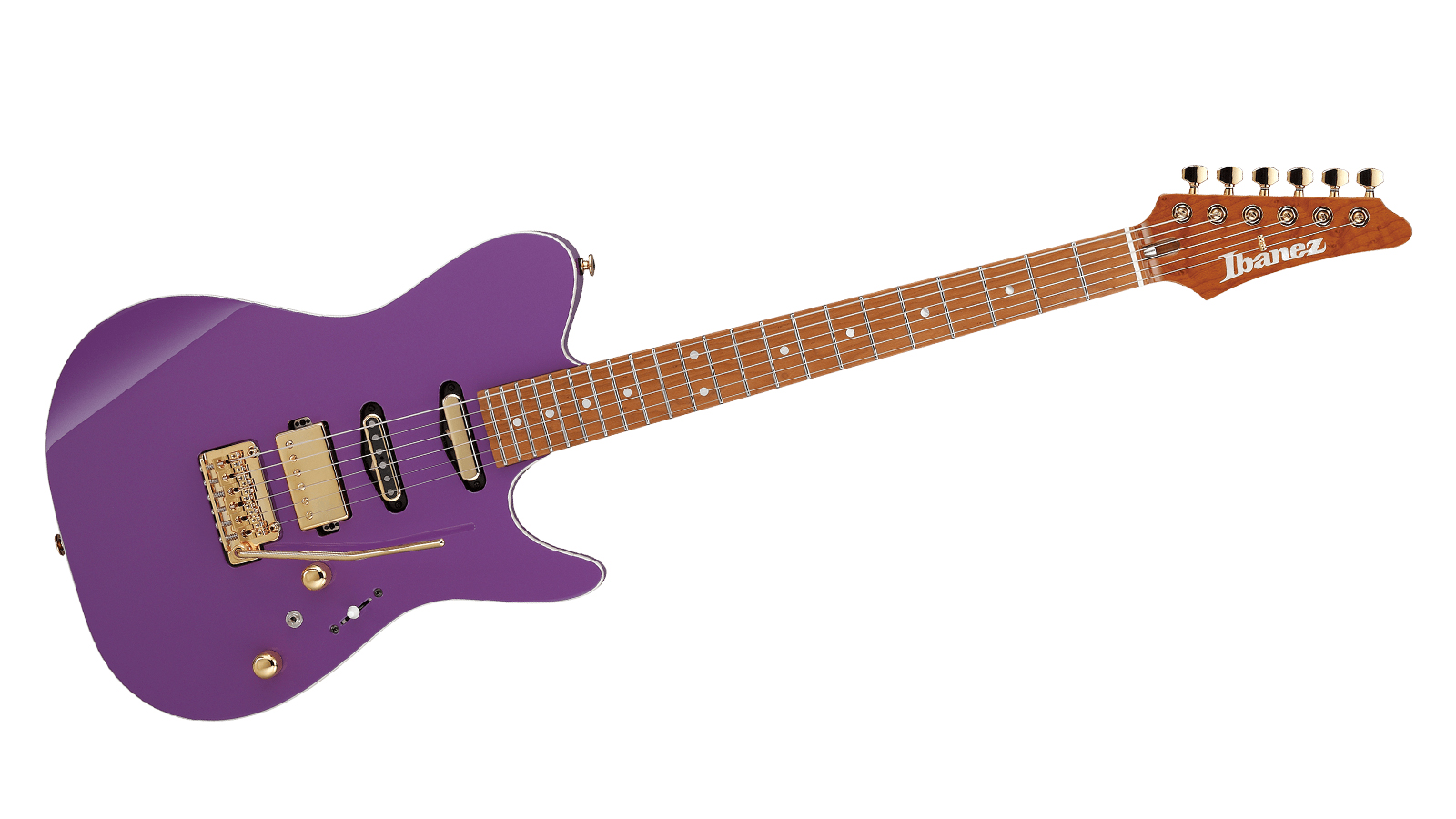
12. Ibanez LB1 Lari Basilio
Our expert review:
Specifications
Reasons to buy
Reasons to avoid
Lari Basilio is one of the most highly regarded guitarists around today, and her Japan-made signature model LB1 is the perfect instrument for any guitarist of her caliber.
Like many higher-end Ibanez guitars, the LB1 is based on the AZ platform – but has an Ash body as opposed to the Alder and Basswood bodies of similar models. The roasted Bird's Eye Maple neck and fingerboard not only looks stunning, but is also responsible for the punchy, Fender-esque response and resonance that comes from playing the LB1.
The LB1 has a HSS pickup configuration consisting of three Seymour Duncan Lari Basilio signature pickups – which all offer a medium to high output. These pickups annunciate the high end clarity and sweetness that this guitar is capable of producing, while the bridge humbucker also shares its dark side. Gotoh hardware finishes off this killer signature guitar, so you wont need to worry about anything slipping out of tune.
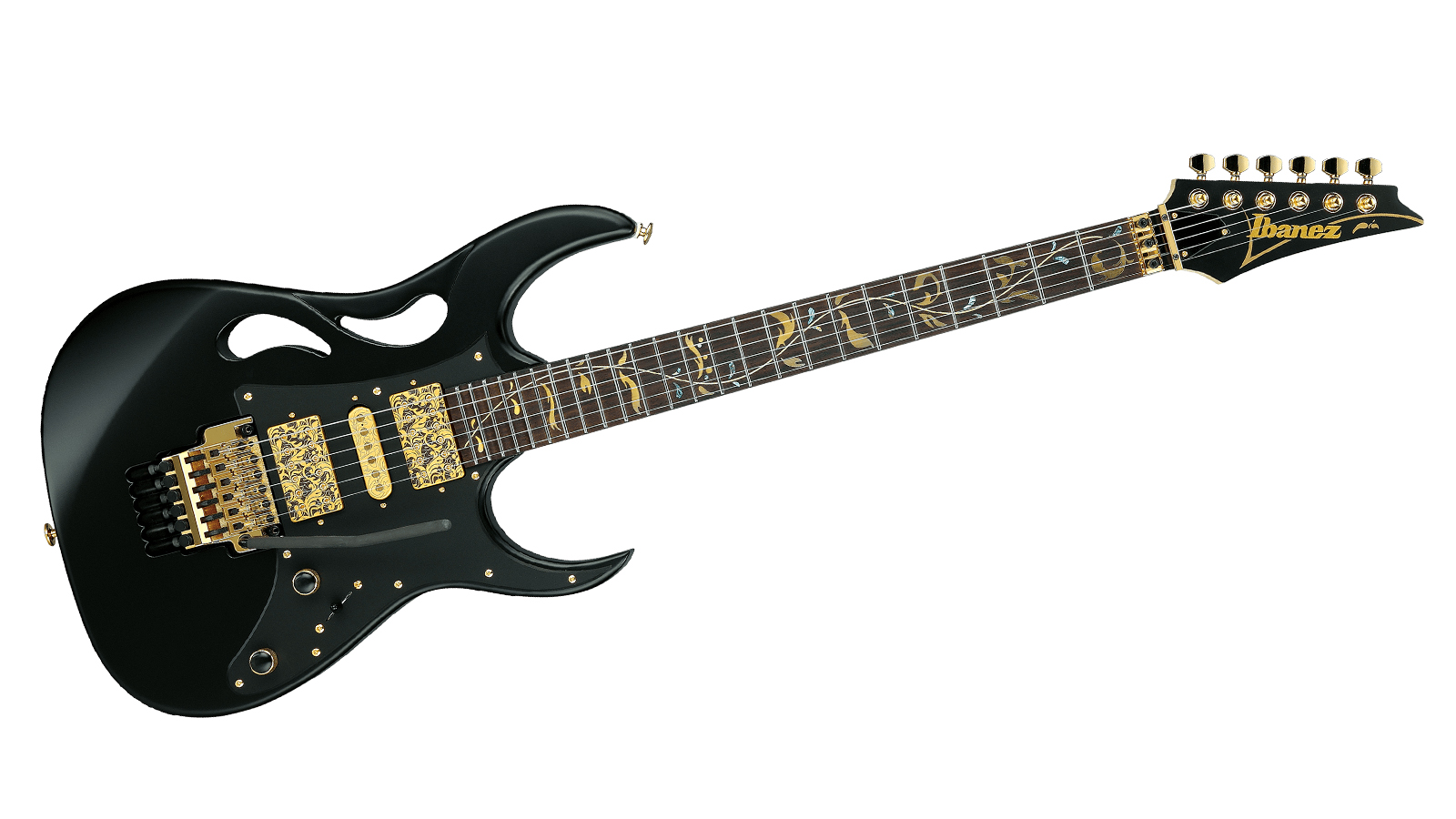
13. Ibanez PIA3761 Steve Vai
Our expert review:
Specifications
Reasons to buy
Reasons to avoid
If you've been alive in at least the last 20 years, then you'll know Steve Vai and his epic range of signature Ibanez guitars. Although the most famous of Vai's signature collection is the JEM, the PIA takes many of the same design cues, albeit with subtle differences. For instance – the monkey-grip-esque handle and ornate fingerboard inlay.
The PIA is a Superstrat fan's dream, and for those who love a bit of Vai, you can't currently get closer to his tone from any other guitar. The PIA was designed for a reason, and that was to create one of the cleverest, most capable tools money can buy.
For a guitarist who's appeared on over 60 albums, you'd expect only the very best – and that's exactly what has happened here with the PIA. The $3.5k price tag feels a little outlandish, but you get one hell of a guitar for the money – so if you can afford it, we'd suggest you just go for it.
Best Ibanez guitars: Buying advice
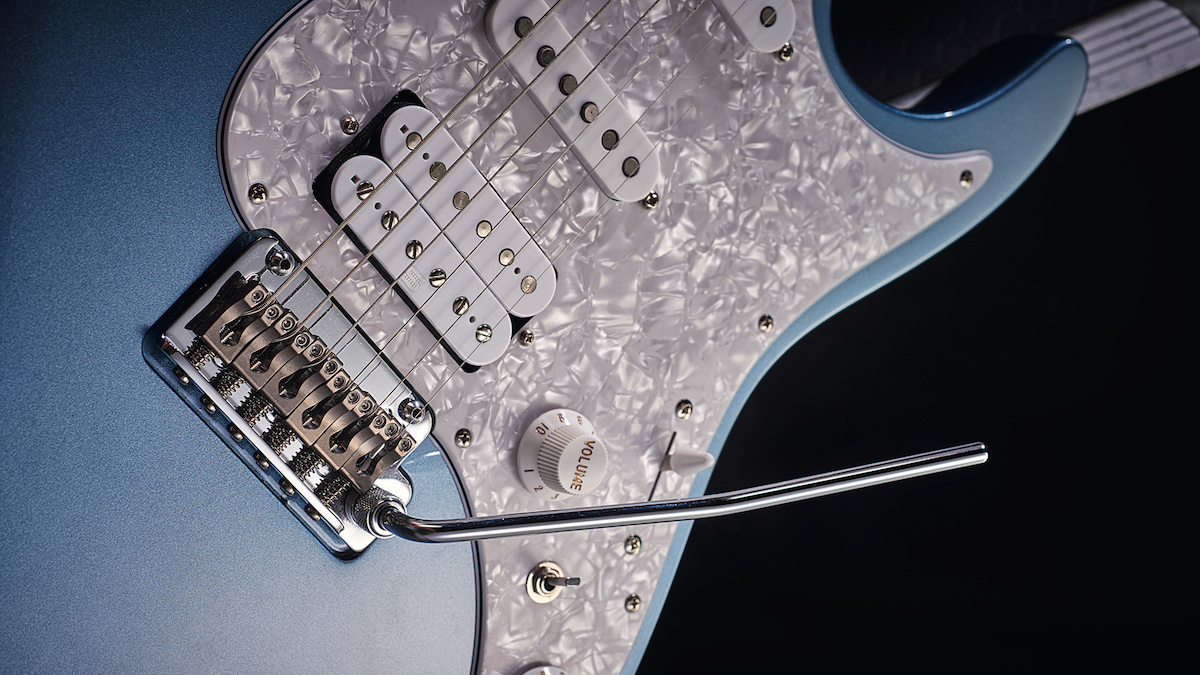
Ibanez guitars: A brief history
You can trust Guitar World
In 1935, Hoshino Gakki – the musical instrument sales division of Japanese bookstore chain Hoshino Shoten – started making Spanish-style nylon string guitars under the name Ibanez Salvador. This was an homage to the Spanish luthier Salvador Ibáñez.
It wasn’t until 1957 that the modern era of Ibanez was founded, with the models on offer throughout the late ‘50s and early ‘60s being manufactured by Guyatone, Kiso Suzuki Violin and also in Gakki’s own Tama factory. After various factory closures and reshuffles over the following years, Ibanez’s guitar production was taken to the FujiGen Gakki guitar factory, where most Ibanez guitars were built up until the mid-to-late ‘80s.
This period was one of Ibanez’s most fruitful, as Hoshino Gakki’s relationship with Steve Vai led to the introduction of the JEM and Universe models – and after the success of the more affordable Roadstar and Iceman models from the late ‘70s and ‘80s, Gakki entered the market with the RG series, a more budget-friendly version of the JEM.
Throughout the time since, Ibanez has been at the forefront of electric guitar design and development, delivering the first ever mass-produced seven and eight string guitars to the world market, among other achievements. They currently market over 300 models of electric guitar – so you should manage to find at least one or two you fall in love with.
What to look for in the best Ibanez guitars
We’re confident that you’ll find at least one guitar that you love on this list, so if you’re looking to buy one of the best Ibanez guitars, then there are a few things that we’d suggest you consider.
Hardware
The right guitar for you needs to have hardware suitable for your playing style. Ibanez offers plenty of guitars with fixed bridges for those who never use a tremolo arm, and Strat-style trems for those who like to use one within certain parameters. Ibanez usually fits one or two models from each range with a fixed bridge, and the Strat-style tremolo features heavily on their less ‘extreme’ models such as the AZ and YY models, among many others.
For those who wish to make the most of Ibanez’s more ‘extreme’ pedigree, many guitars are available with Ibanez’s own ‘Edge’ locking tremolo system – enabling you to access some crazy trem-based effects à la Steve Vai and Joe Satriani.
The rest of Ibanez’s hardware is often well-made and highly durable, with many models featuring locking tuners from Gotoh. These clamp down on your strings, ensuring that string-slip and tuning issues are kept to a minimum. Ibanez’s cheaper guitars don’t usually feature locking tuners, but still hold up impressively against the competition.
Electronics
Like any other guitar search, it’s important to make sure the Ibanez guitar of your dreams has electronics which suit you. If you love the sound of a single-coil electric guitar pickup, then two humbuckers probably won’t do it for you, and vice versa. While pickups, switching and other electronics can be changed, it’s preferable if your guitar has exactly what you need straight from the factory.
Ibanez offers loads of different pickup configurations on their guitars, including different amounts of pickups, sizes, output levels, brands and more. Their switching setups are mostly traditional in nature, enabling you to focus primarily on your playing.
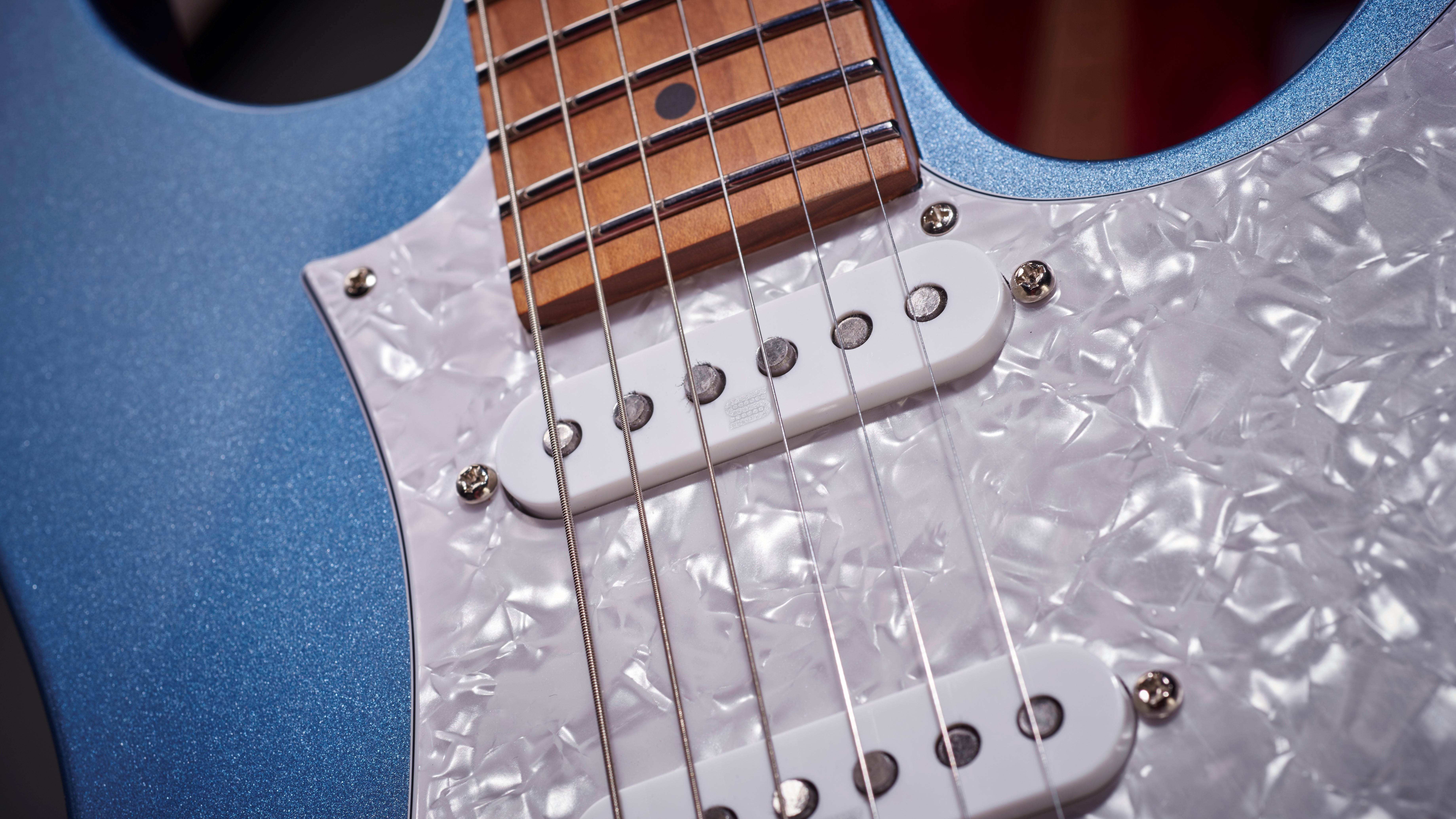
Playability
The playability of a guitar is one criteria that must be met when buying a new model. Ibanez’s main goal – like many other guitar manufacturers – is to only produce easily playable guitars, but everyone has different tastes and preferences when it comes to their setups.
The easiest way to find out whether something is playable is to hold it in your hands; put it on a strap over your shoulder, and see how it feels to play. If you’re not able to try before you buy, then there are a few things to take into account.
If you’re a child or smaller person, then a big-bodied guitar might not be the most appropriate. Unless you’re dying to be the next John Scofield or Pat Metheny, we’d suggest you go for something smaller – it’ll be easier to play, and you’ll improve quicker.
Again, if you’ve got small hands, wider and chunkier neck profiles might not be suitable for you. Keep an eye out for the word ‘slim’ when reading about a guitar’s neck shape, as these will likely be your most comfortable options.
Ibanez ranges explained
Ibanez guitars can largely be split into these four categories:
Gio is Ibanez’s budget range, often made in China or Indonesia, and offers great playability at low costs. Lots of Ibanez’s most treasured high-end models have been recreated for the Gio line, meaning that any beginner guitarist can play something which looks expensive, without shelling out.
The Premium range of guitars are built in Ibanez’s Indonesian premium factory to very high quality standards, and many would argue that this range competes with the Mexican or Korean-made electric guitars of other major manufacturers.
Ibanez’s top of the line Japanese-made models are sold under the Ibanez Prestige name. They feature exceptionally high quality materials, impressive craftsmanship, and a higher level of finish overall – making these guitars some of the best Japanese guitars on the market.
If you’re looking for the best of the best, then the Ibanez J. Custom guitars fit that description to a T. Ibanez says they are ‘envisioned to be the finest Japanese-made guitar in history’, and with some of Ibanez’s most skilled luthiers on the case, that claim is bang on the money.
Find out more about how we make our recommendations and how we test each of the products in our buyer's guides.
Related buyer's guides
- The best Stratocasters for every budget and playing style
- The best metal guitars for shredders on any budget
- Play loud and proud with the best metal amps on the market
- Blow the budget with the best high-end electric guitars
- Best pickups for metal: our guide to upgrading for high gain heaven
All the latest guitar news, interviews, lessons, reviews, deals and more, direct to your inbox!
James is a freelance writer and former Junior Deals Writer at Guitar World. Before writing, James worked as a guitar salesman at a local music store, so he knows a thing or two about matching people with their perfect instruments. James also has experience working in other areas of the music trade, having briefly worked for online music distributor, RouteNote. James is a guitarist, bassist and drummer and has also toured the UK and Europe with his old band Hypophora.

